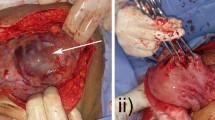Summary
Objective
The aim of this study is to present our experience with surgical management of placenta praevia percreta.
Methods
This study was conducted from January 2009 through March 2014 at Harran University Hospital and was a chart review of all patients who underwent caesarean hysterectomy with the placenta left in situ for placenta praevia percreta.
Results
The study group comprised 58 patients. All of the patients underwent ultrasound mapping of the placental area before surgery. Emergent caesarean hysterectomy was only performed in 9 patients; 49 patients underwent planned caesarean hysterectomy. Bilateral internal iliac artery ligation was performed in all cases. Four patients (6.9 %) had bladder damage, one patient (1.7 %) required cystotomy, and one patient (1.7 %) required re-operation because of postoperative hemorrhage. The mean operative time was 141.6 (range: 95–355) minutes. Only 17 (29.3 %) patients were administered more than four units of red blood cells. There was no ureteral damage or maternal death. Furthermore, there were no complications in 42 (72.4 %) patients.
Conclusions
Caesarean hysterectomy for placenta praevia percreta is associated with increased maternal morbidity. However, preoperative diagnosis of placenta praevia percreta, ultrasound mapping of the placenta, and the presence of a multidisciplinary experienced team may decrease maternal morbidity and mortality. Moreover, the urinary system may be protected in the patients with placenta praevia percreta without serious morbidity.




Similar content being viewed by others
References
Committee on Obstetric Practice. Committee opinion no. 529: placenta accrete. Obstet Gynecol. 2012;120:207–11.
Eller A, Porter T, Soisson P, Silver R. Optimal management strategies for placenta accreta. BJOG. 2009;116:648–54.
Eshkoli T, Weintraub AY, Sergienko R, Sheiner E. Placenta accreta: risk factors, perinatal outcomes, and consequences for subsequent births. Am J Obstet Gynecol. 2013;208:219.e1–7.
Tantbirojn P, Crum CP, Parast MM. Pathophysiology of placenta creta: the role of decidua and extravillous trophoblast. Placenta. 2008;29:639–45.
Silver RM. Abnormal placentation: placenta previa, vasa previa, and placenta accreta. Obstet Gynecol. 2015;126:654–68.
Rezk MA, Shawky M. Grey-scale and colour doppler ultrasound versus magnetic resonance imaging for the prenatal diagnosis of placenta accreta. J Matern Fetal Neonatal Med. 2014;23:1–6.
Camuzcuoglu H, Toy H, Vural M, Yildiz F, Aydin H. Internal iliac artery ligation for severe postpartum hemorrhage and severe hemorrhage after postpartum hysterectomy. J Obstet Gynaecol Res. 2010;36:538–43.
Publications Committee, Society for Maternal-Fetal Medicine, Belfort MA. Placenta accreta. Am J Obstet Gynecol. 2010;203:430–9.
Hoffman MS, Karlnoski RA, Mangar D, et al. Morbidity associated with nonemergent hysterectomy for placenta accreta. Am J Obstet Gynecol. 2010;202:628.e1–5.
Asicioglu O, Sahbaz A, Gungorduk K, Yildirim G, Asicioglu BB, Ulker V. Maternal and perinatal outcomes in women with placenta praevia and accreta in teaching hospitals in Western Turkey. J Obstet Gynaecol. 2014;34:462–6.
University H. Institute of Population Studies. General Directorate of Mother and Child Health/Family Planning. Ankara: Ministry of Health, State Planning Organization, Scientific and Technological Research Council of Turkey (TUBITAK): The Turkey Demographic and Health Survey Hacettepe University, Institute of Population Studies; 2008.
Ji W, Wang W, Sun S, et al. A clinical analysis of uterine artery embolisation in the treatment of placenta praevia or placenta praevia state. J Obstet Gynaecol. 2014;34:585–7.
Palacios-Jaraquemada JM. Caesarean section in cases of placenta praevia and accreta. Best Pract Res Clin Obstet Gynaecol. 2013;27:221–32.
Ballas J, Hull AD, Saenz C, et al. Preoperative intravascular balloon catheters and surgical outcomes in pregnancies complicated by placenta accreta: a management paradox. Am J Obstet Gynecol. 2012;207:216.e1–5.
Teo SB, Kanagalingam D, Tan HK, Tan LK. Massive postpartum haemorrhage after uterus-conserving surgery in placenta percreta: the danger of the partial placenta percreta. BJOG. 2008;115:789–92.
Butt K, Gagnon A, Delisle MF. Failure of methotrexate and internal iliac balloon catheterization to manage placenta percreta. Obstet Gynecol. 2002;99:981–2.
Fitzpatrick KE, Sellers S, Spark P, Kurinczuk JJ, Brocklehurst P, Knight M. The management and outcomes of placenta accreta, increta, and percreta in the UK: a population-based descriptive study. BJOG. 2014;121:62–70.
Price FV, Resnik E, Heller KA, Christopherson WA. Placenta praevia percreta involving the urinary bladder: a report of the two cases and a review of the literature. Obstet Gynecol. 1991;78:508–11.
Caliskan E, Tan O, Kurtaran V, Dilbaz B, Haberal A. Placenta previa percreta with urinary bladder and ureter invasion. Arch Gynecol Obstet. 2003;268:343–4.
O’Brien JM, Barton JR, Donaldson ES. The management of placenta percreta: conservative and operative strategies. Am J Obstet Gynecol. 1996;175:1632–8.
Matsubara S. Bladder-opening technique for hysterectomy for placenta previa percreta. Arch Gynecol Obstet. 2011;283:1427–8.
Cali G, Giambanco L, Puccio G, Forlani F. Morbidly adherent placenta: evaluation of ultrasound diagnostic criteria and differentiation of placenta accreta from percreta. Ultrasound Obstet Gynecol. 2013;41:406–12.
Pelosi MA 3rd, Pelosi MA. Modified cesarean hysterectomy for placenta previa percreta with bladder invasion: retrovesical lower uterine segment bypass. Obstet Gynecol. 1999;93:830–3.
Ferrazzani S, Iadarola R, Perrelli A, et al. Use of an intrauterine inflated catheter balloon in massive post-partum hemorrhage: a series of 52 cases. J Obstet Gynaecol Res. 2014;40:1603–10.
Author information
Authors and Affiliations
Corresponding author
Ethics declarations
Conflict of interest
A. Camuzcuoglu, M. Vural, N. G. Hilali, A. Incebiyik, H. H. Yuce, A. Kucuk, and H. Camuzcuoglu declare that there are no actual or potential conflicts of interest in relation to this article. The authors alone are responsible for the content and writing of the paper.
Rights and permissions
About this article
Cite this article
Camuzcuoglu, A., Vural, M., Hilali, N.G. et al. Surgical management of 58 patients with placenta praevia percreta. Wien Klin Wochenschr 128, 360–366 (2016). https://doi.org/10.1007/s00508-016-0962-4
Received:
Accepted:
Published:
Issue Date:
DOI: https://doi.org/10.1007/s00508-016-0962-4




